Is there a health hazard if a hydrogen peroxide solution accidentally gets into the eye, and what is the prognosis in case of a corneal burn due to such a situation? These questions concern those who use the solution for household, cosmetic or medicinal purposes. What are the first aid measures, symptoms for which you should consult a doctor as soon as possible, ways to prevent complications and eliminate negative consequences?
What is hydrogen peroxide
The medical preparation peroxide or hydrogen peroxide (chemical formula H2O2) is a three percent aqueous solution for external use. This colorless, odorless liquid is used to treat wounds or cuts, and in some cases is used as a means of disinfecting thermal burns. Peroxide is an antiseptic. Oxygen released during contact of the solution with damaged skin promotes the separation and removal of dead areas of the epidermis, blood and purulent clots.
Other indications for the use of peroxide are rinsing the mouth or throat for the purpose of deodorization and disinfection. For rinsing, the solution is diluted with water to reduce the concentration of the active substance. Using three percent peroxide, ears are cleaned of wax plugs; the use of the product for this purpose is widespread in veterinary medicine. Taking peroxide orally for diseases of the gastrointestinal tract, as well as for the treatment of diseases of the heart and blood vessels (Neumyvakin’s method) causes a lot of controversy and is assessed differently by representatives of traditional medicine.
There are many other uses for hydrogen peroxide other than as a disinfectant and antiseptic medicine. Traditional healers recommend the solution for the treatment of colds, infections of the oropharynx and ears, and a remedy for foot fungus. A widely known method of lightening hair is using perhydrol. In everyday life, the product is used as part of solutions for cleaning mirrors, kitchen appliances, washing dishes, and removing stains. If you use the solution carelessly, you can get a burn, including if it comes into contact with the mucous membrane of the eye.
Is it possible to wash your eyes with hydrogen peroxide?
Traditional medicine recommends a peroxide solution as an eye wash for conjunctivitis (inflammation of the ocular mucous membrane) or after a corneal burn. For this purpose, a peroxide solution with a concentration of 0.5 to 1% is used, that is, the medication purchased at the pharmacy is diluted with water in the proportion of one part of the solution to five or six parts of purified water. The mixture is instilled under the eyelids 3-4 times a day for a week. If a solution with a concentration of three percent or higher gets into the eye, it can lead to a burn of the mucous membrane or cornea.
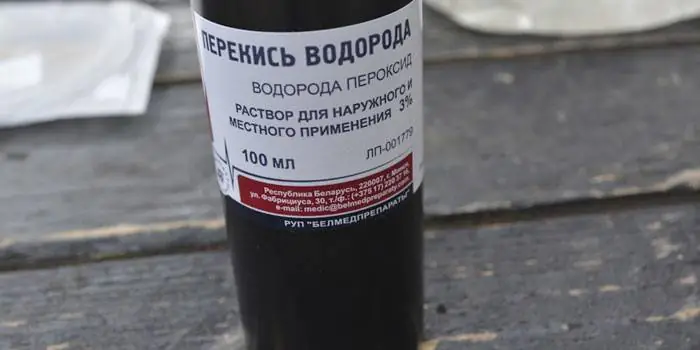
Peroxide got into my eye
Caution must be used when using peroxide solution as a hair coloring or cleaning product. It is necessary to take urgent measures to prevent the onset of negative consequences if hydrogen peroxide gets into the eye. Ways to prevent them include washing the affected eye with plenty of water and immediately seeking advice from an ophthalmologist, especially if there is pain or burning, severe redness or watery eyes.
Burn symptoms
Getting hydrogen peroxide into the eyes can have a number of negative health consequences, and in the case of high doses or concentrations of the solution (more than 40%) can even lead to loss of vision. A burn from hydrogen peroxide manifests itself in the form of the following symptoms:
- irritation of the mucous membrane, leading to severe redness of the eyes due to dilated or burst vessels;
- profuse lacrimation from the injured eye;
- sensation of pain, burning of the eye of varying severity;
- the appearance of ulcers on the cornea with the threat of perforation (formation of a through hole);
- temporary loss or severe impairment of vision;
- photophobia;
- eyelid burns, eyelash loss;
- blindness.
Complications and consequences
Getting hydrogen peroxide into the eyes can lead to unpleasant negative effects of a temporary nature when we are talking about a solution of three percent or less. The burn area may swell (for example, the skin of the eyelid); in the absence of measures to eliminate the consequences, the following may occur:
- cloudiness or redness;
- deterioration of vision or short-term loss of vision;
- pain, burning, other unpleasant sensations.
If a solution of higher concentrations, for example 30% perhydrol, comes into contact, we are talking about a chemical burn, which can threaten much more serious consequences - loss of vision for a long time. In any case, the first aid measure is to wash the eye with plenty of running water and seek help from an ophthalmologist.
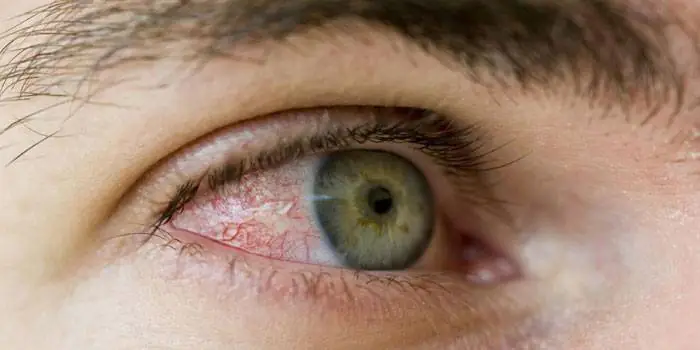
What to do if you have a peroxide burn
If peroxide gets into the eye, it is necessary to take a number of simple measures aimed at removing the substance from the mucous membrane and neutralizing the harm caused by the solution. Perform these simple manipulations in any case, regardless of the peroxide concentration:
- Clean the damaged ocular surface from any remaining solution. This must be done by rinsing with plenty of running water.
- In order to soothe the mucous membrane and neutralize the disinfectant effect after rinsing, you can drip soothing drops (Lidocaine, Levomycetin). The use of similar ointments is not recommended.
- Take a horizontal position, close your eyelid and cover your eye with a dry, ironed cloth. Lie like this for 15-20 minutes.
- Consult a doctor to diagnose the damage, especially if vision disturbances or other negative effects occur, and to receive recommendations for restoring eye health.
Levomycetin eye drops are antibacterial drugs, therefore, in case of eye damage (chemical burns), they are used not only to relieve irritation, but also to prevent the development of concomitant infection. Self-prescription of the drug without receiving medical advice is undesirable. The ophthalmologist will select the necessary treatment regimen, course duration and dosage. Use is contraindicated during pregnancy and children. In the case of a child, it is necessary to select another treatment.
In case of deep damage, pain and irritation, lidocaine eye drops can be used to relieve symptoms and soften damaged mucous membranes. This is a local anesthetic that has a tonic effect on the optic nerve; 5-15 minutes after instillation, vision improvement is observed. Relieves sharp acute pain, prevents the development of complications. Buried under the eyelid.
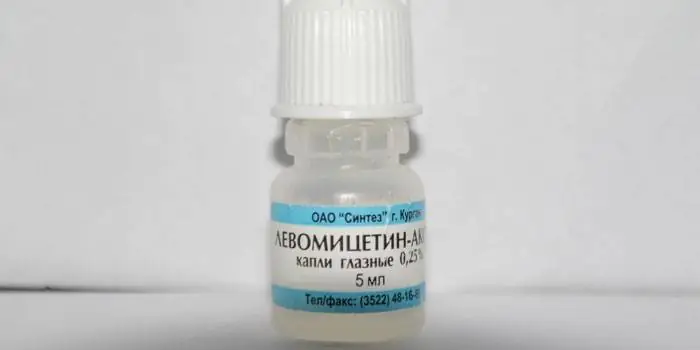
Traditional treatment
If hydrogen peroxide gets into your eyes, you can use the recommendations of traditional healers to eliminate damage and heal damaged mucous membranes or skin of the eyelids. Before using any prescription, check with your healthcare provider. After peroxide gets on the mucous membrane of the eye, you need to rinse it with enough water, and then resort to one of the following treatment methods:
- Eyelid compress with sea buckthorn oil and vitamin E: thoroughly moisten a small piece of bandage with a mixture of sea buckthorn oil and vitamin E in a 1:1 ratio, apply to the eyelid from the outside, hold on the eye for 20-30 minutes. The longer the procedure, the greater the amount of the mixture will be absorbed into the skin of the eyelid and will soften the resulting irritation.
- Rinsing with infusion of birch buds and leaves: prepare a solution - 1 tbsp. dry herbal raw materials (can be purchased at a pharmacy), pour two glasses of boiling water, leave for an hour, strain. Rinse your eyes with the mixture three times a day. The duration of treatment is from 7 to 12 days.
- Compresses with infusion of clover flowers: 1 tbsp. Pour boiling water over the vegetable raw materials and cool. Make compresses with the resulting infusion twice a day - morning and evening. Duration of treatment is 7-10 days.
- Compresses with chamomile oil. Dilute chamomile oil with purified water in a ratio of 2:1; Apply compresses with the resulting mixture to the eyelid of the affected eye twice a day. The duration of treatment is one week. If there is a burn to the eyelid, the oil can be instilled under the eyelid undiluted, every 6-8 hours, until the discomfort disappears.
Hydrogen peroxide is a disinfectant that has hemostatic properties and is used not only for disinfecting wounds, but also for gargling and mouthwash. Sometimes when using the drug, the question arises: what to do if hydrogen peroxide gets into the eye.
If the active substance comes into contact with mucous membranes, it may cause irritation or burns. This is due to the fact that when hydrogen peroxide interacts with tissues, an oxidative reaction occurs and free oxygen is formed. If the product gets into the eye, it is necessary to rinse the affected area with clean running water several times as quickly as possible. , this will help remove remnants of the drug from the mucous membrane and significantly alleviate the condition. If pain, burning and other discomfort do not go away, it is recommended to consult a specialist doctor for advice.
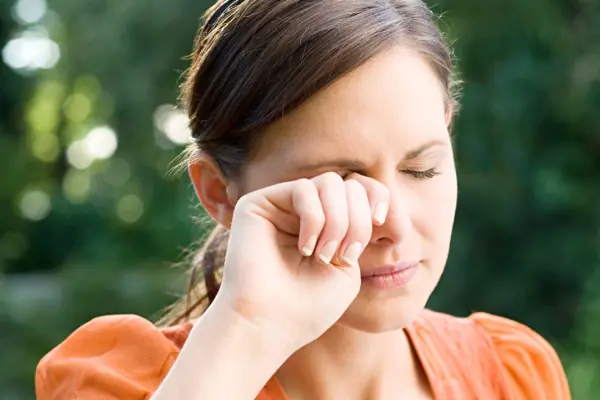
Can I use eye product?
The drug is not intended for use in ophthalmology and is not prescribed for procedures associated with infectious and inflammatory eye pathologies, including conjunctivitis. It is also not recommended to rinse your eyes with hydrogen peroxide, as this can cause irreparable damage to the mucous membranes. The medicine can irritate the mucous membranes and cause a burn, especially in patients with a history of individual intolerance to the active substance.
When can a doctor prescribe
Hydrogen peroxide is used for disinfection in the following cases:
- shallow wound surfaces (abrasions, scratches);
- therapy for stomatitis and tonsillitis (mouth and throat rinsing);
- gynecological pathologies.
For small wounds, due to the hemostatic properties, Peroxide will help stop the bleeding.
As we can see, the official instructions for use do not include ophthalmological diseases. This means that you cannot rinse or drip hydrogen peroxide into your eyes.
Contraindications
The drug is not used if the patient has a history of hypersensitivity to the composition of the drug.
The use of Hydrogen Peroxide is carried out with extreme caution:
- for violations of renal and hepatic functions of a decompensated nature;
- with hyperthyroidism (increased thyroid function);
- with dermatitis herpetimorphis.
Application
Hydrogen peroxide is used externally only. During procedures, avoid contact with the eyes and esophagus.
To disinfect wound surfaces, a 1 - 3% concentration of the drug is used. The procedure is carried out in compliance with antiseptic rules. The dressing material should be soaked in the medicine and the affected area should be treated.
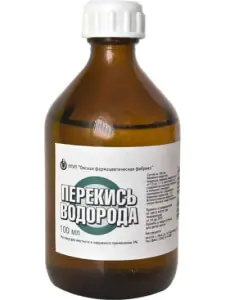
For sore throat and stomatitis, a 0.25% solution of hydrogen peroxide is used, and it is used to rinse the mouth.
If hydrogen peroxide gets into a child's eye while rinsing or treating a wound, the first step is to quickly rinse the eyes with clean running water. If the burning sensation, pain and irritation do not go away, you should consult an ophthalmologist for advice. This situation can be quite dangerous, so you cannot hesitate.
Overdose
If peroxide accidentally enters the respiratory tract, the mucous membrane of the digestive system may be irritated and bronchospasms may occur.
Penetration of hydrogen peroxide into the esophagus can cause damage to the gastrointestinal mucosa, hemolysis and hemoglobinuria. If more than 3 g of the drug enters the stomach, serious consequences, including death, are possible.
That is why it is very important to strictly follow the instructions when using the product.
Overdose is treated as follows:
- administration of a large dose (up to 300 ml) of sodium thiosulfate 30% (intravenously);
- gastric lavage with sodium thiosulfate 0.5% or sodium bicarbonate.
Features of use
If the drug gets on the mucous membranes, discomfort may develop. Hydrogen peroxide may cause the eye to turn red and cause a burning sensation. To avoid this, procedures should be carried out very carefully and in the dosage specified in the instructions.
The use of hydrogen peroxide does not provide sterilization and does not guarantee protection against tetanus infection.
The drug is approved for use by pregnant women and nursing mothers, but its use should only be used in cases of extreme necessity.
Conclusion
Hydrogen peroxide is a disinfectant that has a huge number of positive reviews from doctors and patients. Its effectiveness has been proven by many years of experience. However, when using it, you must strictly follow the instructions for use.
Despite numerous information on this topic, wiping your eyes with hydrogen peroxide is not recommended, as this can cause irritation and burn the mucous membrane. If the product does get into your eyes, you should take the following measures: rinse immediately with running water until the discomfort disappears.
Sources:
Vidal:
GRLS: >
Found a mistake? Select it and press Ctrl + Enter
Getting various substances into the eyes is a common everyday situation. Often people do not attach any importance to them, or, on the contrary, consider it very dangerous and begin to take decisive measures. How dangerous is it really if peroxide gets into your eye?
Is it possible to rinse and drip eyes with hydrogen peroxide?
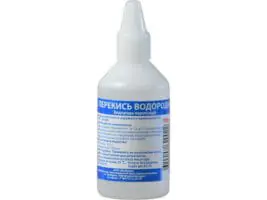
Hydrogen peroxide has a powerful antiseptic effect - it destroys bacteria in the places it comes into contact with. Its action is based on the fact that the compound itself is unstable and easily breaks down into water and oxygen.
Excess oxygen has a detrimental effect on bacteria, but it is also unsafe for human tissue. Contact of peroxide with the mucous membrane of the eye can cause a violent chemical reaction and tissue burns.
Accidental ingestion of small amounts of peroxide is not dangerous to the eyes, but the introduction of large quantities of peroxide is harmful. Therefore, wiping the skin around the eyes, including the eyelids, with an antiseptic is acceptable. Eye drops for conjunctivitis can be taken with peroxide at a concentration of 0.5% and only as prescribed by a doctor.
Peroxide is included in solutions for cleaning lenses - it cleans them, removes protein deposits, and prevents the development of bacteria. But such solutions must be used strictly according to the instructions. The peroxide in them is in a concentration that does not harm the eyes.
What to do if peroxide gets into your eye
If undiluted topical peroxide gets into your eye, there is no need to be alarmed. The main thing to do is to rinse your eyes with running water. The less time the medicine comes into contact with the mucous membrane, the less harm it will cause.
Further actions depend on the condition of the eyes - if you feel only mild discomfort and slight redness, then no action needs to be taken. If pain and severe redness occur, you need to drip your eyes with Lidocaine or Levomycetin drops. These drugs relieve pain in the eye and speed up healing, preventing complications. If these steps do not help, you need to consult a doctor.
Is it dangerous
Accidental contact of peroxide with the eyes when wiping the skin of the face is not dangerous - it only causes an unpleasant burning sensation in the eye, but does not cause serious harm.
The danger comes from getting undiluted peroxide for external use in large quantities into the eye. But it’s better to play it safe and wash your eyes every time a suspicious substance gets into them.
In what cases is a burn possible?

A burn to the cornea of the eye is possible if peroxide comes into contact with a concentration of more than 3%. A weaker solution will cause severe discomfort, but is safe if you rinse your eyes in time.
The danger comes from dropping it into the eye, trying to rinse it with undiluted peroxide from a pharmacy, or carelessly wiping nearby areas of the skin.
Symptoms of a burn
You can distinguish a burn from a normal injury by the following signs:
- A burning sensation that is poorly relieved by painkillers;
- Redness of the eyes;
- lacrimation;
- Photophobia;
- Swelling of the eyelids;
- Loss of eyelashes;
- Deterioration of vision;
- Ulcers on the cornea.
If no action is taken, these symptoms will progress. To treat a chemical burn, you need to see an ophthalmologist.
Possible consequences and complications
The most common complications of a burn are infectious. Damaged tissues become convenient entry points for bacteria, and against the background of a burn, purulent inflammatory processes easily develop - conjunctivitis, blepharitis, keratitis, which can lead to the spread of infection further into the eyeball.
A long-term burn, even without inflammatory complications, can lead to the development of a cataract - an opaque area of the cornea that impairs vision or completely prevents the damaged eye from seeing.
How to avoid them
You can avoid complications by promptly seeking medical help. The doctor will prescribe eye drops with antibiotics and agents that accelerate corneal recovery.
This eliminates bacteria, prevents severe bacterial complications from developing and reduces the risk of cataract formation.
What to do if peroxide gets into your eye
Getting peroxide into the eye does not necessarily lead to the terrible consequences listed in the previous section. In most cases, this only causes severe discomfort, but is not too dangerous to health.
Therefore, the first thing to do when peroxide gets into your eye is to calm down. Fear is not the best helper; it can lead to rash actions.
First aid

Actions to take if undiluted peroxide gets into your eyes:
- Rinsing the eyes with running water (from the tap, but preferably boiled water);
- Instillation of anesthetic and disinfecting drops (Lidocaine, Visin, Levomycetin, artificial tears);
- You need to lie down with a clean napkin on the affected eye for 10-15 minutes.
These actions are effective in most cases of peroxide getting into the eyes, they are safe for the patient and allow you to get rid of unpleasant sensations. If this is not enough, pain occurs, the condition worsens, you need to consult a doctor.
Further treatment
First aid in most cases helps to cope with the consequences of peroxide getting into the eyes - after these actions the patient feels well. However, minor effects from a chemical burn can last for several hours.
The patient may feel discomfort, photophobia, and increased lacrimation. During this period, it is advisable to protect your eyes from bright light, exposure to caustic substances and visual stress.
If there is concern that an infection may have entered the eye, it is possible to re-use disinfectant drops. Painkillers can be used repeatedly if the mucous membrane of the eyes is highly sensitive and the pain does not go away quickly. If you need to use painkillers more than twice, or the condition worsens, you should consult a doctor.
In what cases is medical assistance needed?
Treatment by a doctor is necessary in cases where the actions described above were not enough to ensure good health or it was not possible to provide full first aid. Signs that you need to see a doctor:
- Getting a large amount of undiluted peroxide into the eyes;
- Inability to provide first aid to the victim in a timely manner;
- Discomfort in the eyes does not go away, despite the measures taken;
- There could be an infection in the eye;
- The patient has recently suffered an eye injury or conjunctival injury;
- Signs of a purulent infection appeared.
In this case, the patient should be transported to an ophthalmology clinic. It is necessary to ensure sterile conditions - there should be no infection in the eye, so it must be covered with a sterile bandage or clean cloth. If the patient's condition does not allow him to get to the hospital on his own, you should call an ambulance.
Treatment
Long-term treatment for such conditions is usually not required. In a hospital setting, the patient’s eyes are additionally washed with sterile solutions to eliminate damaging factors, a course of medications is prescribed, and if necessary, they are left for a while under the supervision of a doctor.
If complications arise, they also need to be dealt with, following the doctor’s recommendations.
Folk
Folk remedies will help relieve irritation and improve the patient’s well-being after peroxide gets into the eye. It is advisable to use them only as prescribed by a doctor as an additional treatment, but they are not suitable as a primary treatment.
To relieve swelling of the eyelids, you can make a compress with sea buckthorn oil. To do this, lubricate a clean napkin with oil and apply it to the closed eye. With such a compress you can do household chores, but it is better to lie down for 10-15 minutes. It can be done 3-4 times a day to relieve swelling of the eyelids.
Compresses and rinses with chamomile help get rid of itching and irritation, speed up the healing of the mucous membrane and prevent bacterial complications from developing. An aqueous infusion of chamomile is used, which is used morning and evening.
If drug treatment is prescribed, first wash the eyes with chamomile, then administer medications (so that the decoction does not reduce their effectiveness). Instead of chamomile, you can use clover, birch buds, and oak bark. Do not use alcohol tinctures - they irritate the eyes and aggravate the burn.
Medication
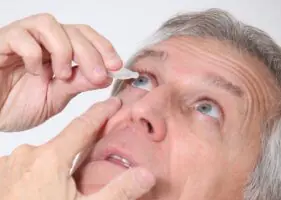
The doctor will prescribe a course of treatment, which depends on the degree of eye damage. For preventive purposes, a combination of an antiseptic (Sulfacyl sodium, Okomistin, Albucid) and a drug for corneal healing (Balarpan) in the form of eye drops is prescribed. The course of treatment is a week. Medicines can avoid bacterial complications and speed up the healing process.
If signs of a bacterial infection appear, drugs with antibacterial action are prescribed - Ofloxacin, Tobramycin, Tsipromed. They fight bacteria, prevent their spread and treat inflammatory processes. Eye antiseptics are used together with them - they increase the effectiveness of antibacterial agents, and means for restoring the cornea - this reduces the chance of its clouding.
Severe complications are treated promptly. If a cataract has formed, it is impossible to cope with it and restore full vision.
Features of treatment if peroxide gets into a child’s eye
The peculiarity of childhood trauma is that the baby is unlikely to realize that he is violating safety precautions, so peroxide can get into his eyes in large quantities, and parents will not notice it immediately, so the consequences can be very dangerous.
The procedure for parents is the same - rinse the eyes, apply pain-relieving drops, let the baby lie down, and protect the cornea from bright light and aggressive substances during the entire recovery period. You should consult a doctor in the same cases as in adults, and also if you do not know what substance got into your eye.
To avoid such situations, you should store aggressive liquids, including peroxide, in locked cabinets so that the child cannot use them. All hygiene procedures that require wiping the face with peroxide should only occur under the supervision of adults.
Watch a video on how to properly rinse your eyes:



